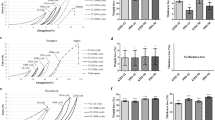Abstract
Titanium and its alloys are used worldwide in surgery. The favorable characteristics that make this material desirable for implantation are corrosion resistance and biocompatibility. Concerning hernia repair, a mesh modification has been developed using titanium layering of a polypropylene mesh implant, which is said to lead to an improved biocompatibility compared to commercially available mesh materials. To analyze the pure effect of titanium coating, two different mesh structures were studied using a standardized animal model. The titanium-coated monofilamentous, large porous, and lightweight mesh made of polypropylene and coated with titanium (PP+T) was compared to a pure polypropylene mesh manufactured with a similar structure and amount of material serving as a control (PP). In Sprague-Dawley rats, mesh samples were placed in a subcutaneuous position. Then 56, 84, and 182 days after mesh implantation, three animals from each group were sacrificed for morphological observations (amount of inflammatory and connective tissue formation, percentages of proliferating and apoptotic cells, percentage of macrophages). Both mesh modifications investigated showed an overall good biocompatibility. Macroscopic clinical observation after implantation of up to 182 days was uneventful. The tissue response to the PP as well as to the PP+T mesh was characterized by a moderate inflammatory tissue reaction limited to the perifilamentary region as is known for low weight, large porous, and monofilamentous mesh structures. No significant improvement of biocompatibility was found when analyzing the effect of titanium coating compared to the pure polypropylene mesh structure.


Similar content being viewed by others
References
Macintyre IM (2003) Best practice in groin hernia repair. Br J Surg 90:131–132
Leber GE, Garb JL, Alexander AI, Reed WP (1998) Long-term complications associated with prosthetic repair of incisional hernias. Arch Surg 133:378–82
Losanoff JE, Richman BW, Jones JW (2002) Entero-colocutaneous fistula: A late consequence of polypropylene mesh abdominal wall repair: Case report and review of the literature. Hernia 6:144–147
Weitzel SH, Botha AJ, Thomas PA (1998) Late colocutaneous fistula after mesh repair of an inguinal hernia. Hernia 2:39–40
Welty G, Klinge U, Klosterhalfen B, Kasperk R, Schumpelick V (2001) Functional impairment and complaints following incisional hernia repair with different polypropylene meshes. Hernia 5:142–147
Scheidbach H, Tamme C, Tannapfel A, Lippert H, Köckerling F (2003) The biocompatibility of various polypropylene meshes. In: Köckerling F (ed): Hernia repair with titanium coated polypropylene mesh. Science Med, Hannover pp 1–11
Assad M, Lemieux N, Rivard CH, Yahia LH (1999) Comparative in vitro biocompatibility of nickel-titanium, pure nickel, pure titanium, and stainless steel: genotoxicity and atomic absorption evaluation. Biomed Mater Eng 9:1–12
Wever DJ, Veldhuizen AG, Sanders MM, Schakenraad JM, van Horn JR (1997) Cytotoxic, allergic and genotoxic activity of a nickel-titanium alloy. Biomaterials 18:1115–1120
Junge K, Klinge U, Rosch R, Klosterhalfen B, Schumpelick V (2002) Functional and Morphologic Properties of a Modified Mesh for Inguinal Hernia Repair. World J Surg 26:1472–1480
Carinci F, Volinia S, Pezzetti F, Francioso F, Tosi L, Piattelli A (2003) Titanium-cell interaction: analysis of gene expression profiling. J Biomed Mater Res 2003 66B:341–346
Hummel RC (2000) Titanium. Cambridge Scientific Abstracts
Klinge U, Klosterhalfen B, Ottinger AP, Junge K, Schumpelick V (2002) PVDF as a new polymer for the construction of surgical meshes. Biomaterials 23:3487–3493
Klinge U, Klosterhalfen B, Conze J, Limberg W, Obolenski B, Ottinger AP, Schumpelick V (1998) Modified mesh for hernia repair that is adapted to the physiology of the abdominal wall. Eur J Surg 164:951–960
Klosterhalfen B, Klinge U, Hermanns B, Schumpelick V (2000) Pathologie traditioneller chirurgischer Netze zur Hernienrepartion nach Langzeitimplantation im Menschen. Chirurg 71:43–51
Lehle K, Buttstaedt J, Birnbaum DE (2003) Expression of adhesion molecules and cytokines in vitro by endothelial cells seeded on various polymer surfaces coated with titaniumcarboxonitride. J Biomed Mater Res 65A:393–401
Lehle K, Lohn S, Reinerth GG, Schubert T, Preuner JG, Birnbaum DE (2004) Cytological evaluation of the tissue-implant reaction associated with subcutaneous implantation of polymers coated with titaniumcarboxonitride in vivo. Biomaterials 25:5457–5466
Kumazawa R, Watari F, Takashi N, Tanimura Y, Uo M, Totsuka Y (2002) Effects of Ti ions and particles on neutrophil function and morphology. Biomaterials 23:3757–3764
Klinge U, Junge K, Stumpf M, AP AP, Klosterhalfen B (2002) Functional and morphological evaluation of a low-weight, monofilament polypropylene mesh for hernia repair. J Biomed Mater Res 63:129–136
Klinge U, Klosterhalfen B, Birkenhauer V, Junge K, Conze J, Schumpelick V (2002) Impact of polymer pore size on the interface scar formation in a rat model. J Surg Res 103:208–214
Author information
Authors and Affiliations
Corresponding author
Rights and permissions
About this article
Cite this article
Junge, K., Rosch, R., Klinge, U. et al. Titanium coating of a polypropylene mesh for hernia repair: Effect on biocompatibilty. Hernia 9, 115–119 (2005). https://doi.org/10.1007/s10029-004-0292-8
Received:
Accepted:
Published:
Issue Date:
DOI: https://doi.org/10.1007/s10029-004-0292-8




